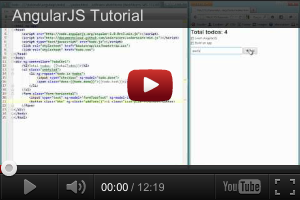Data Binding
Data-binding is an automatic way of updating the view whenever the model changes, as
well as updating the model whenever the view changes. This is awesome because it
eliminates DOM manipulation from the list of things you have to worry about.
Controller
Controllers are the behavior behind the DOM elements. AngularJS lets you express the
behavior in a clean readable form without the usual boilerplate of updating the DOM,
registering callbacks or watching model changes.
Plain JavaScript
Unlike other frameworks, there is no need to inherit from proprietary types in order
to wrap the model in accessors methods. AngularJS models are plain old JavaScript
objects. This makes your code easy to test, maintain, reuse, and again free from
boilerplate.
Directives
Directives are a unique and powerful feature available in AngularJS. Directives let
you invent new HTML syntax, specific to your application.
Reusable Components
We use directives to create reusable components. A component allows you to hide
complex DOM structure, CSS, and behavior. This lets you focus either on what the
application does or how the application looks separately.
Localization
An important part of serious apps is localization. AngularJS's locale aware filters
and stemming directives give you building blocks to make your application available in
all locales.
Deep Linking
A deep link reflects where the user is in the app. This is useful so users can
bookmark and email links to locations within the app. Round trip apps get this
automatically, but AJAX apps by their nature do not. AngularJS combines the benefits
of deep linking with desktop app-like behavior.
Form Validation
Client-side form validation is an important part of a great user experience. AngularJS
lets you declare the validation rules of the form without having to write JavaScript
code. Write less code, go have beer sooner.
Server Communication
AngularJS provides built-in services on top of XHR as well as various other backends
using third party libraries. Promises further simplify your code by handling
asynchronous return of data.
Injectable
The dependency injection in AngularJS allows you to declaratively describe how your
application is wired. This means that your application needs no main()
method which is usually an unmaintainable mess. Dependency injection is also a core to
AngularJS. This means that any component which does not fit your needs can easily be
replaced.
Testable
AngularJS was designed from ground up to be testable. It encourages behavior-view
separation, comes pre-bundled with mocks, and takes full advantage of dependency
injection. It also comes with end-to-end scenario runner which eliminates test
flakiness by understanding the inner workings of AngularJS.

